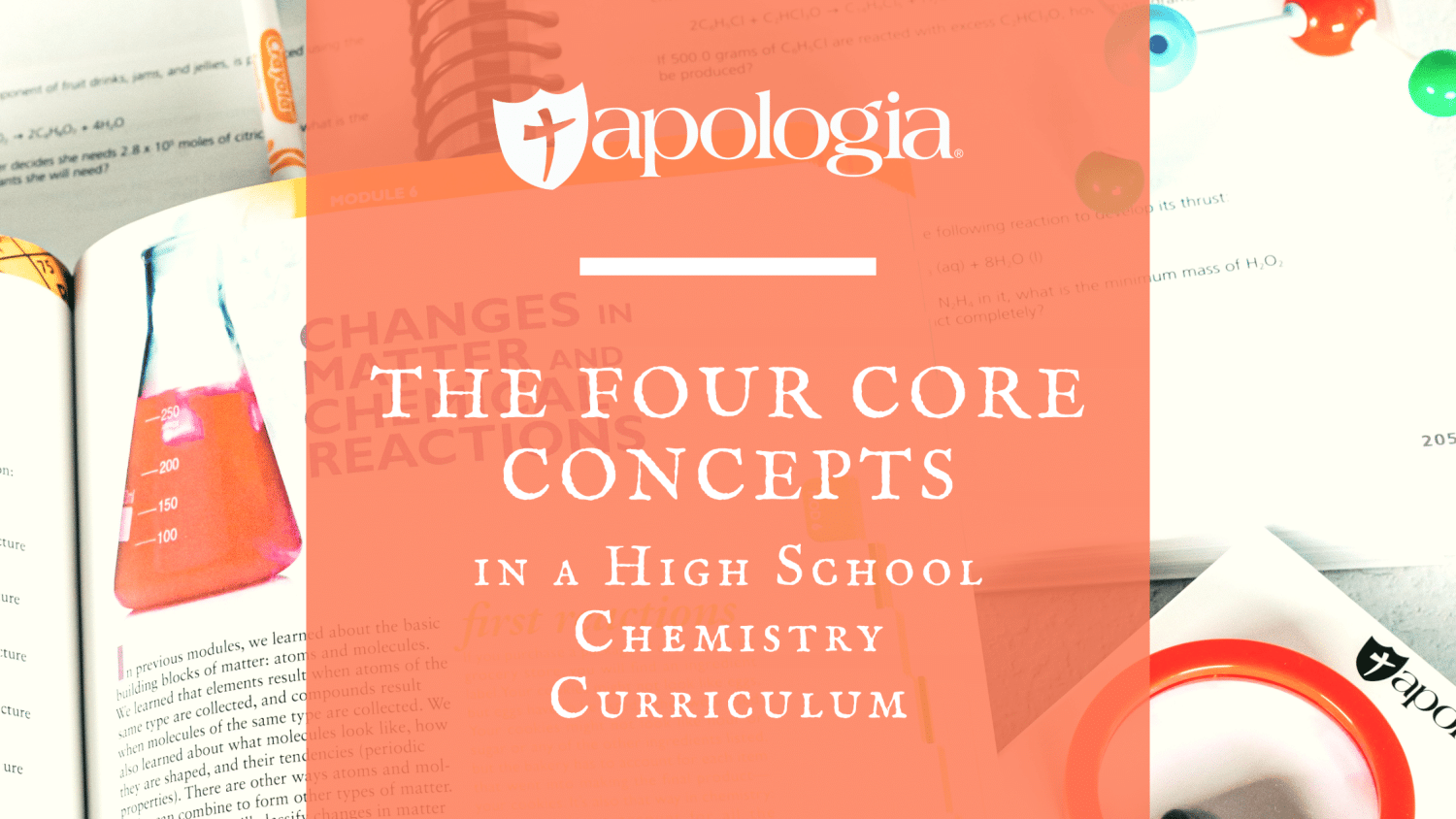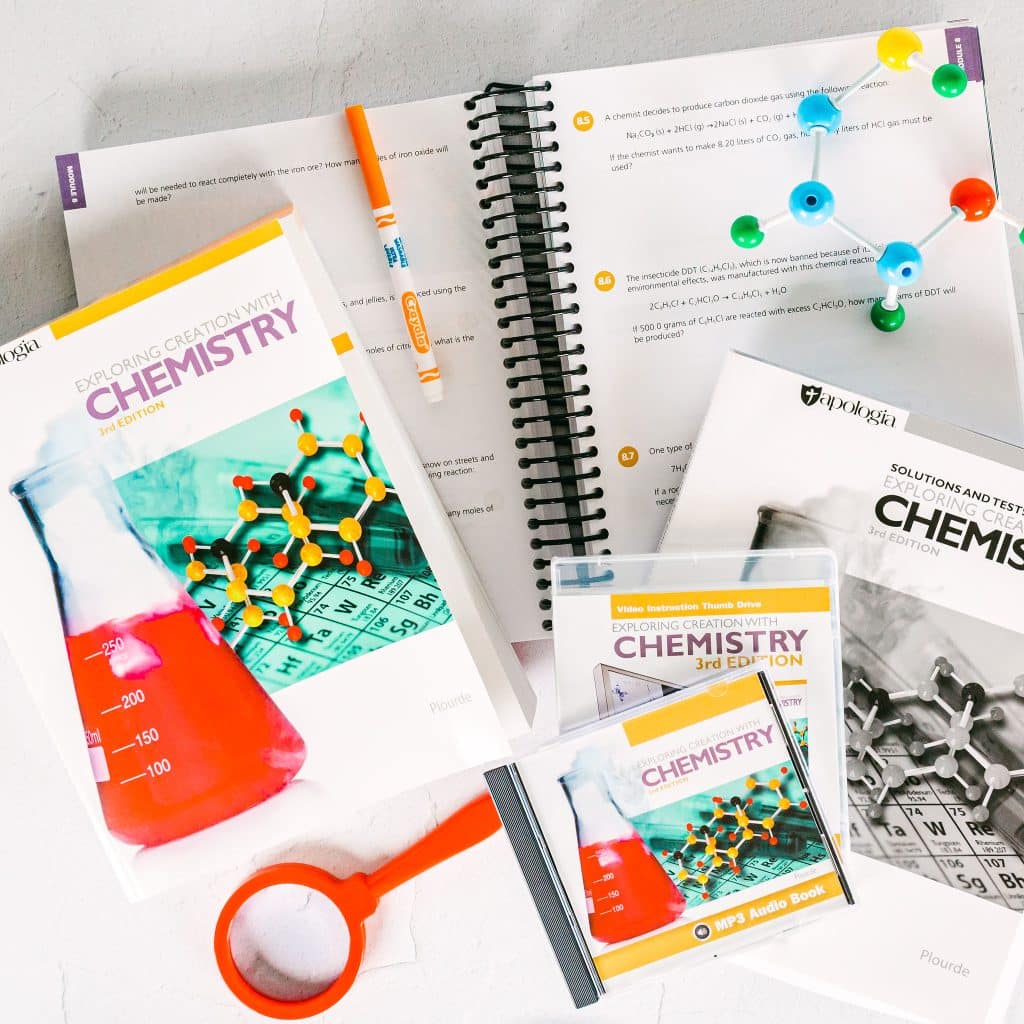
The Four Core Concepts in a High School Chemistry Curriculum
Teaching a high school homeschool chemistry curriculum will help your students sharpen their critical thinking skills, practice lab techniques, and develop a better understanding of chemistry. With Apologia, you’ll get all that and the benefit of learning it from a Biblical point of view.
Teaching high school curriculum, particularly a topic as complex as chemistry, can be overwhelming. But breaking it down to the four core concepts your students need to know can keep some anxiety at bay.
Core Concept 1: Structure & Behavior of Matter
Students will study how particle structure and arrangement influence properties and change.
They will:
- Research the different states of matter
- Compare mixtures and solutions
- Understand bonding and intermolecular forces
- Distinguish physical from chemical changes
- Classify reaction types
- Use balanced equations and stoichiometry to conserve atoms
Some courses will also introduce nuclear chemistry to ensure changes in the nucleus and other associated energy are discussed.
Core Concept 2: Energy in Chemical Systems
Energy plays a key role in every high school chemistry curriculum. Part of this topic includes tracking energy conservation across systems, quantifying heat and work in thermochemistry, and understanding thermodynamics to gauge how it frames the spontaneity and limits of energy and heat. Other elements taught include:
- How electrochemistry converts chemical energy to electrical work
- Conservation of energy and energy transfer
- The different definitions of energy
- Scientific reasoning and engineering design
Concepts such as bonding and intermolecular forces, as well as electrochemistry and the nature of science, should also be taught.
Read more: How to Keep Kids Motivated & Engaged When Homeschooling
Core Concept 3: Forces & Stability in Chemistry
A High School chemistry curriculua should address how atomic- and molecular-scale forces demonstrate links to macroscopic behaviour. In this section, learners will:
- Revisit periodicity and atomic structure
- Compare ionic and covalent bonding
- Connect molecular shape and intermolecular forces to material properties
- Analyze reaction types
As part of this topic, other concepts such as electrochemistry, chemical engineering, and the different types of chemical reactions will also be introduced.
Core Concept 4: Light, Waves, & Atomic Models
Finally, students will take a look at light, waves, and atomic models to meet and understand the quantum ideas that underlie atomic structure and spectral lines. They’ll also:
- Place light within the electromagnetic spectrum
- Perform quantitative analysis to measure concentration
- Learn about modern instrumentation and information technologies
- Develop an understanding of how waves and light are used to investigate matter and communicate data
They may also explore how spectroscopy and photonics power sensory and medical diagnostics.
Apologia’s Top Tips For Teaching High School Chemistry at Home
If it’s your first time homeschooling high school chemistry, take a look at some of our tips for ensuring your student gets the most out of their course:
Bring Chemistry to Life with Virtual Labs & Multimedia
Hands-on expiriments can be just as important as book knowledge, especially when trying to grasp complex concepts. That’s why it’s important to allow them to try experiments. A hands-on approach helps to bring the content to life. If your home isn’t easily set up to perform experiements, videos of the experiments are a great option.
Ground Concepts in Real-World Contexts
When a curriculum grounds complex concepts in a real-world context, it helps make it easier for students to comprehend those topics. For example, cooking is a great chemistry-related topic that will make their learning more relatable and memorable—so you know it will stick in their minds.
Visualize Chemistry with Particle Diagrams
Color and illustrations can go a long way when it comes to the learning and development of teenagers in high school chemistry. For example, aim to use color-coded particle diagrams to illustrate how atoms interact, rearrange in reactions, or go into solution. These visuals are powerful for clarifying big ideas like stoichiometry, dissolution, and energy changes—especially when hands-on labs are limited.
Find a High School Chemistry Curriculum with Faith-Based Teachings
Learning high school chemistry from a biblical worldview is an invaluable opportunity for homeschooled and private Christian school students. Students in public education will be taught these conecpts with God removed from the subject entirely. Being that He created it, students in public education will miss out on learning what God would teach us through Chemistry and understanding Him as the Creator.
Apologia’s High School Chemistry Curriculum
If you’re looking for a concise high school chemistry curriculum that provides both clear-cut teachings while still upholding faith-based concepts, and college preporatory level education, Apologia can help. Our homeschool chemistry curriculum prepares students for college-level science in a way that is accessible to their own unique learning style.
For more information, check out the details of our curriculum, live classes, or self-paced courses.




